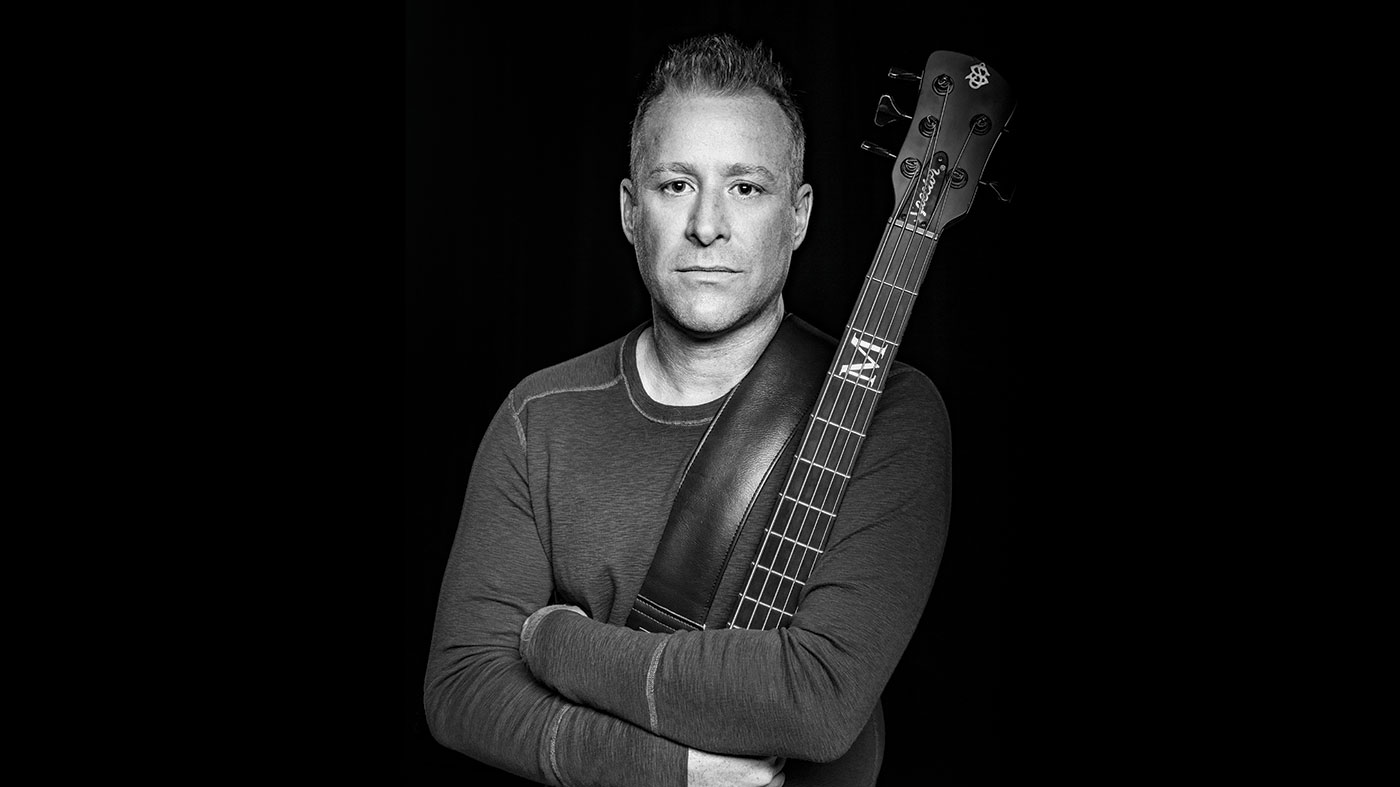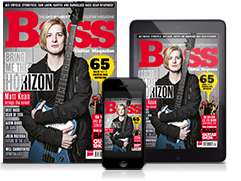Nickelback's Mike Kroeger: “I’ve got what many could consider the biggest bass amp in the world… a 1.5-million watt PA!”
The long-serving bassist on amp-free rigs, playing to the fans and his indestructible Spectors

It’s often said that everyone loves you until you become the competition, and few bands know this as much as Nickelback.
When they became that self-same competition in 2001 with their breakthrough album, Silver Side Up, haters crawled out of the woodwork in droves to spew online venom. But revenge, it’s also said, is a dish best served cold, and to date, Nickelback - vocalist/guitarist Chad Kroeger, guitarist Ryan Peake, bassist Mike Kroeger and drummer Daniel Adair - have sold over 50 million albums, released more than 23 chart-topping singles, and completed 12 consecutive sold-out world tours, playing to over eight million fans.
These numbers have continued to increase as the band launch into a 2018 European tour accompanying their ninth studio album, Feed The Machine.
With the bass guitar in hard rock, less is often more
Asked about his band’s brand of hard rock with pop sensibilities, loaded with memorable hooks and choruses, the affable bassist Mike Kroeger tells us that Nickelback’s fans are paramount.
“They’ve developed a taste for what we do, so we don’t want to go too far and shake them off,” he says.
“On the previous album, No Fixed Address, we explored more diverse territory stylistically. Some of that was received well and some of it was not - and that’s by our people - so you come to expect it when you push the envelope that far. As far as my bass performance goes, I always take a minimalist approach. With the bass guitar in hard rock, less is often more. If you can raise the foundation, leave space for the vocal and the feeling of the song, make the band sound as heavy as possible, and give it an undeniable bedrock - that’s the plan.”
Nickelback, he says, is both the sum of its parts and the sum of its influences. For Kroeger, that includes everything from dance music to metal to James Brown.
Get the MusicRadar Newsletter
Want all the hottest music and gear news, reviews, deals, features and more, direct to your inbox? Sign up here.
“Every once in a while, little influences come out,” he says. “You bring your palette to the studio, and sometimes when you splash colours on the canvas, it works, and sometimes it’s not the place or time. It’s a balance, and you try to achieve that balance in a completely unbalanced environment. After all, you’re in a room with four to six extreme personalities, and you’re aiming to take them all and make one cohesive, cogent thought.”
A solid Spector
He adds: “I usually find I’m more comfortable playing the bass parts after about six months on the road, and I wish that I could record them after playing them. Some artists spend a lot of time in the jam room rehearsing before they record. We write as we record, and we record as we write, so a lot of the stuff that you hear on Nickelback albums happened in the studio and got kept.
“As we go on the road, everybody becomes more comfortable with the parts and you can put in more minute inflections, but as a duty to the listeners you don’t want to go too far and change it up so much that it affects the song and makes it sound different from what’s on the recording.”
I’ve got backups for my backups. [Spector basses] never break down... they are my American Express card: never leave home without them
To get that sound, Kroeger relies on Spector basses.
“Over the years, Stuart has built me somewhere in the neighbourhood of 15 or 18 of them, including my signature MK-5 Pro, and I think I have eight or 10 of them on the road,” he says.
“I’ve got backups for my backups. They never break down, I’ve never had a problem with them, but they are my American Express card: never leave home without them - the Spector collection of handmade beautiful wood made by Stuart Spector, the master.”
He adds: “I don’t really use amps live at all. I’ve got what many could consider the biggest bass amp in the world - a 1.5-million watt PA! - so an amp would be a little bit redundant, I guess you could say. I get all of my tones direct now and it’s pretty raw. We’ve done some things in the studio with amps, and there is some gear that I like, but for the most part it’s my hands into a Spector NS-5XL, and whatever happens beyond that is colour.”
He plays with both fingers and picks, and is partial to Dunlop .88 triangles.
“I feel like you get a lot more meat on the strings with those,” he says. “I do play with my fingers, but I also play with a pick because I find it makes the distortion pop a lot better and you get that grind out of the attack that obviously you can’t get with fingers. If you want to get that, you’ve got to fuzz it into oblivion, and I like to keep the wave from getting too square and have the gain down enough so there’s a lot of headroom and it can still crunch.”
Strings? “Ernie Ball standard five-string Slinky sets, of course. No Nickelback show would be complete without Ernie Ball. Every stringed instrument on our stage is Ernie Ball.”
Motivation
Kroeger has been amp-free for close to a decade. “It was the best day in my tech’s life, because he stopped humping around hundreds of pounds of gear every day,” he says.
“There was a learning curve, similar to going with in-ear monitors. It feels different and it takes a little while to get used to. Not having an amp blasting on the stage really took some getting used to as well. But, like in-ear monitoring, after you get used to it, you realise that the possibilities are endless and the accuracy is unparalleled.
“We use a lot of Radial Engineering gear, and I’m in the process of seeing what kind of tone I can coax out of this Radial 500 Series rig. They make a lot of direct rack gear for bass, but they’re more studio-oriented, so I’m trying to create a live rig with their equipment. We use Radial for all of our direct interfaces and switching; all the guitars and bass use them.
Don’t stand in front of a stadium full of people and think, oh, I’m just doing it for me, and all these people just happen to like it too
“One thing I’ve used over the years and had fun with is the Hartke Bass Attack pedal. At the end of a tour quite a long time ago, we were opening boxes of things that all these companies had given us so graciously, and we found this pedal. It did stuff to the tone that we hadn’t found before, so we started to dial that in.
“That pedal has a preamp tube in it, and it started to take my tone in an entirely different direction, so that’s a fixture in the rig, as is the Electro-Harmonix Big Muff Pi. We need that for the song Too Bad, where the verses have that square wave Big Muff thing going.”
Millions of miles, album sales and packed venues later, Kroeger remains grateful, never complains about the workload, and is keenly aware of what he often calls the chain of command, with the fans positioned at the top.
“There are some self-indulgent artists out there,” he observes. “You know that old chestnut: ‘I’m just in it for the music, man’. That’s cool, I get that. You’ve got to be in it for the music. That’s a given. But, as my brother once said, if you’re only playing for yourself, why would you ever take your amp out of your bedroom? Just stay home and do whatever it is. If it’s three chords and the truth, or shredding a million miles an hour, or whatever it is in between those two things - if you’re only doing it for yourself, then just keep doing it for yourself. That’s where you should be. But don’t stand in front of a stadium full of people and think, oh, I’m just doing it for me, and all these people just happen to like it, too.”
“The self-indulgent artist will always be there, and sure, there is the exception where every once in a while someone says, ‘Fuck that, I’m doing it my way’, and everybody does happen to like it, but that is a rarefied event.
“For the most part, if you’re out there and you’re playing for a bunch of people, you’re beholden to them. They are who put you up there, and you’ve got to respect that. Does it mean you owe them everything? No. But when it comes to you being on the stage, and you writing the songs and making the records, you’ve got to be cognisant of who you’re working for.”
Nickelback are playing UK arenas in May.


“Its mission is simple: unleash the power of any amplifier or line-level source without compromise”: Two Notes promises a “watershed” in tube amp control with the Torpedo Reload II
“A pedal that sings with harmonic richness and blooming touch response”: Tone King offers up boutique tube amp tones for your pedalboard with the Imperial Preamp









